Список султанов Османской империи — Википедия
| Султан Османской империи | |
|---|---|
| тур. Osmanlı İmparatorluğu'nun Sultanı | |
 Штандарт Султана Османской империи | |
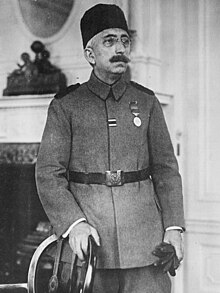 Последний в должности Мехмед VI | |
| Должность | |
| Возглавляет | |
| Форма обращения | Его Величество |
| Резиденция | Топкапы |
| Назначались | По наследию |
| Срок полномочий | Пожизненный |
| Предшествующая | Удж-бей Сёгюта |
| Появилась | 1299 год |
| Первый | Осман I Гази |
| Последний | Мехмед VI |
| Заменившая | Президент Турецкой Республики |
| Упразднена | 1 ноября 1922 года |

Султан Османской империи (тур. Osmanlı İmparatorluğu'nun Sultanı) — титул монархов Османской империи из династии Османов, правившей в 1299—1922 годах.
История титула
[править | править код]Турки-османы происходили из огузского племени кайи, обитавшего в Средней Азии в области Мерва. Спасаясь от нашествия монголов, часть племени откочевала на запад, где их предводители находились на службе у хорезмшаха Джалал уд-Дина. Затем небольшое подразделение кайи, во главе с Эртогрулом[1], направилась во владение румского султана Кей-Кубада I, который пожаловал ему удж Сёгюта в Анатолии, на границе с византийскими владениями.
В 1402 году среднеазиатский завоеватель Тамерлан разгромил османов под Анкарой[2]. Султан Баязид I попал в плен[3], где и умер. Государство османов Тимур разделил на части. Лишь Мурад II смог вновь восстановить единство государства. C XVI века продолжилась мощная экспансия турок[4].
В 1517 году Селим I уничтожил государство мамлюков в Египте и присоединил Египет к своим владениям[5]. Он также принял новый титул халифа правоверных. Османские султаны носили титул халифа вплоть до 1924 года.
Постепенно усилившись, турки-османы захватили огромные территории, включавшие в себя весь Балканский полуостров, Малую Азию, Северную Африку вплоть до Марокко, Сирию, Палестину, Аравийский полуостров, Месопотамию, Закавказье и Крым[6].
В 1909 году султана Абдул-Хамида II свергли, следовательно, абсолютная монархия в Османской империи перестала существовать. На престол взошёл ранее бесправный брат Абдул-Хамида II Мехмед V[7]. Ситуация в Османской империи при нём стала стремительно ухудшаться.
В 1922 году султан Мехмед VI покинул страну. Практически с этого момента монархия в Османской империи перестала существовать. Документально это было оформлено 29 октября 1923 года, когда была провозглашена Турецкая республика. 3 марта 1924 года был упразднён халифат[8]. Более в Турции монархия не возрождалась.
Список правителей
[править | править код]Предки Османской династии
[править | править код]- Гюндуз Альп[12]
- Эртогрул-бей, сын Гюндуз Альпа, уджбей Сёгюта до 1281/1288 (?)[источник не указан 1555 дней] года
Правители Османского государства
[править | править код]| Султан | Портрет | Начало правления | Конец правления | Тугра | Прим. |
|---|---|---|---|---|---|
| Образование Османской империи (1299—1453) | |||||
| Осман I (Фахр уд-Дин Осман-бей) |  | 1299 | 1324/6 | — | |
| Орхан (Ихтияр уд-Дин Орхан-бей, прозванный также Победоносный) |  | 1324/6 | 1360 |  | |
| Мурад I[15] |  | 1360 | 15 июня 1389 |  |
|
| Баязид I Йылдырым (Молниеносный) |  | 15 июня 1389 | 20 июля 1402 |
| |
| Османское междуцарствие (20 июля 1402 — 5 июля 1413) | |||||
| Мехмед I Челеби (Гияс- эд-Дин Мехмед-хан) | 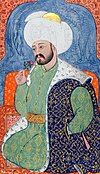 | 5 июля 1413 | 26 мая 1421 | ||
| Мурад II | 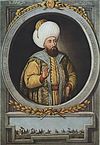 | 25 июня 1421 | 1444 |
| |
| Мехмед II Фатих (Завоеватель) فاتح | 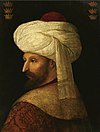 | 1444 | 1446 |
| |
| Мурад II |  | 1446 | 3 февраля 1451 |
| |
| Рост Османской империи (1453—1683) | |||||
| Мехмед II Фатих (Завоеватель)[18] فاتح |  | 3 февраля 1451 | 3 мая 1481 |
| |
| Баязид II[20] Дервиш (Монах) | 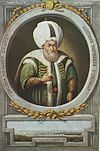 | 19 мая 1481 | 25 апреля 1512 | ||
| Селим I Явуз (Грозный) | 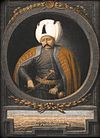 | 25 апреля 1512 | 21 сентября 1520 |
| |
| Сулейман I Мухтешем (Великолепный) или Кануни (Законодатель) |  | 30 сентября 1520 | 6 или 7 сентября 1566 |  |
|
| Селим II Селим Блондин | 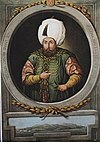 | 29 сентября 1566 | 21 декабря 1574 |
| |
| Мурад III | 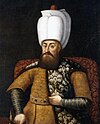 | 22 декабря 1574 | 16 января 1595 |
| |
| Мехмед III | 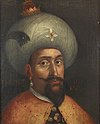 | 27 января 1595 | 20 или 21 декабря 1603 |
| |
| Ахмед I[27] | 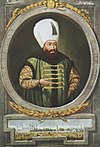 | 21 декабря 1603 | 22 ноября 1617 |
| |
| Мустафа I | 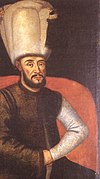 | 22 ноября 1617 | 26 февраля 1618 | ||
| Осман II شهيد |  | 26 февраля 1618 | 19 мая 1622 |
| |
| Мустафа I |  | 20 мая 1622 | 10 сентября 1623 | ||
| Мурад IV غازى |  | 10 сентября 1623 | 8 или 9 февраля 1640 |
| |
| Ибрагим | 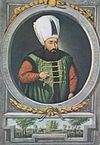 | 9 февраля 1640 | 8 августа 1648 |
| |
| Мехмед IV غازى | 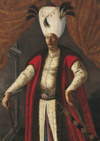 | 8 августа 1648 | 8 ноября 1687 | ||
| Сулейман II |  | 8 ноября 1687 | 22 июня 1691 | ||
| Ахмед II |  | 22 июня 1691 | 6 февраля 1695 |
| |
| Мустафа II | 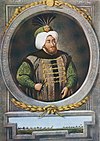 | 6 февраля 1695 | 22 августа 1703 | ||
| Стагнация Османской империи (1703—1827) | |||||
| Ахмед III |  | 22 августа 1703 | 1 или 2 октября 1730 |
| |
| Махмуд I |  | 2 октября 1730 | 13 декабря 1754 |
| |
| Осман III | 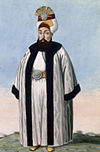 | 13 декабря 1754 | 29 или 30 октября 1757 |
| |
| Мустафа III | 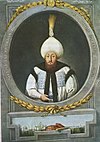 | 30 октября 1757 | 21 января 1774 |
| |
| Абдул-Хамид I |  | 21 января 1774 | 6 или 7 апреля 1789 |
| |
| Селим III | 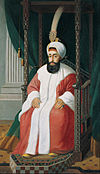 | 7 апреля 1789 | 29 мая 1807 |
| |
| Мустафа IV |  | 29 мая 1807 | 28 июля 1808 |  |
|
| Упадок Османской империи (1827—1908) | |||||
| Махмуд II |  | 28 июля 1808 | 1 июля 1839 |
| |
| Абдул-Меджид I |  | 1 июля 1839 | 25 июня 1861 |  |
|
| Абдул-Азиз |  | 25 июня 1861 | 30 мая 1876 |  | |
| Мурад V | 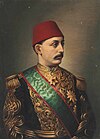 | 30 мая 1876 | 31 августа 1876 |  |
|
| Абдул-Хамид II |  | 31 августа 1876 | 27 апреля 1909 |  |
|
| Распад Османской империи (1908—1922) | |||||
| Мехмед V |  | 27 апреля 1909 | 3 июля 1918 |  |
|
| Мехмед VI |  | 4 июля 1918 | 1 ноября 1922 |  | |
| Халифат (1 ноября 1922 — 3 марта 1924) | |||||
| Абдул-Меджид II | 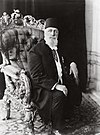 | 18 ноября 1922 | 3 марта 1924 | — | |
См. также
[править | править код]Примечания
[править | править код]- ↑ Kafadar, Cemal. Between Two Worlds: The Construction of the Ottoman State (англ.). — 1995. — P. 60.
- ↑ Dimitris J. Kastritsis, The Sons of Bayezid: Empire Building and Representation in the Ottoman Civil War of 1402-13, (Brill, 2007), 5.
- ↑ Nancy Bisaha, Creating East And West: Renaissance Humanists And the Ottoman Turks, (University of Pennsylvania Press, 2004), 98.
- ↑ Karpat, Kemal H. The Ottoman state and its place in world history (англ.). — Leiden: Brill, 1974. — P. 111. — ISBN 90-04-03945-7.
- ↑ Muir, William. The Mameluke; Or, Slave Dynasty of Egypt, 1260-1517, A. D (англ.). — Smith, Elder, 1896. — P. 207—213.
- ↑ Hess, Andrew C. The Ottoman Conquest of Egypt (1517) and the Beginning of the Sixteenth-Century World War (англ.) // International Journal of Middle East Studies : journal. — 1973. — January (vol. 4, no. 1). — P. 55—76. — doi:10.1017/S0020743800027276. — .
- ↑ Nicolle, 2008, p. 160
- ↑ Hakan Ozoglu. From Caliphate to Secular State: Power Struggle in the Early Turkish Republic (англ.). — ABC-CLIO, 2011. — P. 8. — ISBN 978-0-313-37957-4. Архивировано 14 января 2023 года.
- ↑ BAŞAR, 1995.
- ↑ KOZAN.
- ↑ Imber, 1987.
- ↑ В историографии cчитается доказанным, что отцом Эртогрула был Гюндуз Альп. Была найдена монета с надписью "Осман б. Эртогрул б. Гюндуз Альп"[9][10][11].
- ↑ Kafadar, Cemal. Between Two Worlds: The Construction of the Ottoman State (англ.). — 1995. — P. 60, 122.
- ↑ 1 2 3 4 5 6 7 8 Lowry, Heath. The Nature of the Early Ottoman State. — SUNY Press, 2003. — С. 153.
- ↑ Lambton, Ann[англ.]; Lewis, Bernard. The Cambridge History of Islam: The Indian sub-continent, South-East Asia, Africa and the Muslim west (англ.). — Cambridge University Press, 1995. — Vol. 2. — P. 320. — ISBN 9780521223102. Архивировано 2 апреля 2015 года.
- ↑ Robert Elsie. Historical Dictionary of Kosova. — Scarecrow Press, 2004. — С. 95—96. — ISBN 978-0-8108-5309-6. Архивировано 14 января 2023 года.
- ↑ Kafadar 1996, p. xix
- ↑ Gábor Ágoston; Bruce Alan Masters. Encyclopedia of the Ottoman Empire. — Infobase Publishing[англ.], 2009. — С. 363. — ISBN 978-1-4381-1025-7. Архивировано 14 января 2023 года.
- ↑ Foster, Charles The Conquest of Constantinople and the end of empire. Contemporary Review (22 сентября 2006). — «It is the end of the Middle Ages». Архивировано 11 июня 2009 года.)
- ↑ Sakaoğlu, Necdet «Beyazid II», (1999) Yaşamları ve Yapıtlarıyla Osmanlılar Ansiklopedisi, C.1 s.299-302 İstanbul:Yapı Kredi Kültür Sanat Yayıncılık, ISBN 975-08-0073-7.
- ↑ BAYEZID II (22 сентября 2006). — «It is the end of the Middle Ages». Архивировано 11 июня 2009 года.)
- ↑ A Century of Giants. A.D. 1500 to 1600: In an age of spiritual genius, western Christendom shatters / Ted Byfield, ed.. — The Society to Explore and Record Christian History, 2010. — P. 9. — 345 p. — ISBN 978-0-9689873-9-1.
- ↑ M. Th Houtsma. First encyclopaedia of Islam: 1913-1936. — BRILL, 1993. — С. 522. — ISBN 9004097961, 9789004097964. Архивировано 23 октября 2017 года.
- ↑ The Speech of Ibrahim at the Coronation of Maximilian II, Thomas Conley, Rhetorica: A Journal of the History of Rhetoric, Vol. 20, No. 3 (Summer 2002), 266.
- ↑ Peirce, 1993, p. 95.
- ↑ Peirce, 1993, p. 288.
- ↑ Peirce, Leslie. The Imperial Harem: Women and Sovereignty in the Ottoman Empire (англ.). — Oxford University Press, 1993. — P. 99. — ISBN 0-19-508677-5.
- ↑ Börekçi, 2009, p. 409.
- ↑ Piterberg, Gabriel. An Ottoman Tragedy: History and Historiography at Play (англ.). — California: University of California Press, 2003. — P. 18. — ISBN 0-520-23836-2.
- ↑ Imber, 2009, pp. 98—99.
- ↑ Финкель, 2012, с. 276—277.
- ↑ 1 2 Finkel, Caroline. Osman's Dream: The Story of the Ottoman Empire, 1300-1923 (англ.). — New York: Basic Books, 2005. — P. 197. — ISBN 978-0-465-02396-7.
- ↑ Sonyel, Salâhi Ramadan. Minorities and the destruction of the Ottoman Empire (англ.). — Turkish Historical Society Printing House, 1993. — P. 61. — ISBN 975-16-0544-X.. — «Many of these ladies of the harem were non-Muslim, for example Sultana Kosem (Anastasia), of Greek origin, who was the wife of Ahmet I (1603-17), and the mother of Murat IV (1623-40), and of Ibrahim (1640-8)».
- ↑ Günseli İnal; Semiramis Arşivi. Semiramis: Sultan'ın gözünden şenlik. — YKY, 2005. — С. 27. — ISBN 978-975-08-0928-6. Архивировано 29 апреля 2016 года.. — «Siileyman’in annesi Sirp Katrin yani Dilasiip Hatun».
- ↑ Ali Kemal Meram. Padişah anaları: resimli belgesel tarih romanı (тур.). — Öz Yayınları, 1977. — С. 325.
- ↑ Baker, Anthony E. The Bosphorus. — Redhouse Press, 1993. — С. 146. — ISBN 975-413-062-0.. — «The Valide Sultan was born Evmania Voria, daughter of a Greek priest in a village near Rethymnon on Crete. She was captured by the Turks when they took Rethymnon in 1645.».
- ↑ Bromley, J. S. The New Cambridge Modern History. — University of California: University Press, 1957. — С. 554. — ISBN 0-521-22128-5.. — «the mother of Mustafa II and Ahmed III was a Cretan».
- ↑ Sardo, Eugenio Lo. Tra greci e turchi: fonti diplomatiche italiane sul Settecento ottomano (итал.). — Consiglio nazionale delle ricerche, 1999. — P. 82. — ISBN 88-8080-014-0.. — «Their mother, a Cretan, lady named Rabia Gulnus, continued to wield influence as the Walide Sultan — mother of the reigning sultan».
- ↑ Library Information and Research Service. The Middle East. — Library Information and Research Service, 2005. — С. 91.. — «She was the daughter of a Cretan (Greek) family and she was the mother of Mustafa II (1664—1703), and Ahmed III (1673—1736).».
- ↑ Aksan, Virginia H. Ottoman Wars: 1700-1870. — Harlow: Longman/Pearson, 2007. — ISBN 0582308070.
- ↑ Freely, John. The lost Messiah. — Viking, 2001. — С. 132. — ISBN 0-670-88675-0.. — «He set up his harem there, his favourite being Rabia Giilniis Ummetiillah, a Greek girl from Rethymnon on Crete».
- ↑ Shaw, Stanford J. and Shaw, Ezel Kural (1976) History of the Ottoman Empire and Modern Turkey, volume 1: Empire of the Gazis: the rise and decline of the Ottoman Empire, 1280—1808 Cambridge University Press, Cambridge, England, p. 240, ISBN 0-521-21280-4
- ↑ Upham, Edward[англ.]. Chapter XV: OTHMAN III Twenty Fifth Reign H 1168 A.D. 1754 // History of the Ottoman Empire from its Establishment till the Year 1828 (англ.). — Original from Oxford University: Constable and Co., 1829. — Vol. XL. — P. 260. — (Constable's Miscellany). Архивировано 31 октября 2013 года.
- ↑ 1 2 Hoiberg, Dale H., ed. (2010). "Abdulhamid I". Encyclopædia Britannica. Vol. I: A-ak Bayes (15th ed.). Chicago, IL: Encyclopædia Britannica Inc. p. 22. ISBN 978-1-59339-837-8.
- ↑ Goodwin, Jason: «Lords of the Horizons», Chapter 24: The Auspicious Event, 1998
- ↑ Yavuz Bahadıroğlu, Resimli Osmanlı Tarihi, Nesil Yayınları (Ottoman History with Illustrations, Nesil Publications), 15th Ed., 2009, page 395, ISBN 978-975-269-299-2
- ↑ Kinross, p. 434.
- ↑ Kinross, pp. 456—457
- ↑ Chambers Biographical Dictionary, ISBN 0-550-18022-2, page 3
- ↑ Davis, Claire. The Palace of Topkapi in Istanbul. — New York: Charles Scribner and Sons, 1970. — С. 222.
- ↑ Jamil ADRA. Genealogy of the Imperial Ottoman Family. — 2005. — С. 19. — ISBN 975-7874-09-4.
- ↑ Abdulhamid II | biography - Ottoman sultan. Дата обращения: 29 сентября 2015. Архивировано 28 июля 2018 года.
- ↑ Mehmed V, Selcuk Aksin Somel, Encyclopedia of the Ottoman Empire, 371.
- ↑ Harun Açba. Kadın efendiler: 1839-1924. — Profil, 2007. — ISBN 978-9-759-96109-1. Архивировано 7 июля 2014 года.
- ↑ As̜iroğlu 1992, p. 13
- ↑ As̜iroğlu 1992, p. 17
- ↑ As̜iroğlu 1992, p. 14
Литература
[править | править код]- As̜iroğlu, Orhan Gâzi. Son halife, Abdülmecid (тур.). — Istanbul: Burak Yayınevi, 1992. — (Tarihin şahitleri dizisi). — ISBN 978-9757645177.
- Goodwin, Jason[англ.] (1998). Lords of the Horizons: A History of the Ottoman Empire. New York: H. Holt ISBN 0-8050-4081-1
- Duran, Tülay. Padişah Portreleri (Portraits of the Ottoman Empire's Sultans) (тур.). — Sirkeci: Association of Historical Research and Istanbul Research Centre, 1999. — ISBN 978-9756926079.
- Findley, Carter V. The Turks in World History (англ.). — New York: Oxford University Press US, 2005. — ISBN 978-0-19-517726-8.
- Glazer, Steven A. Chapter 1: Historical Setting // A Country Study: Turkey / Metz, Helen Chapin. — 5th. — Washington, D.C.: Federal Research Division of the Library of Congress, 1996. — (Country Studies). — ISBN 978-0-8444-0864-4.
- Kafadar, Cemal. Between Two Worlds: The Construction of the Ottoman State (англ.). — Berkeley, CA: University of California Press, 1996. — ISBN 978-0-520-20600-7.
- Karateke, Hakan T. Who is the Next Ottoman Sultan? Attempts to Change the Rule of Succession during the Nineteenth Century // Ottoman Reform and Muslim Regeneration: Studies in Honour of Butrus Abu-Manneb / Weismann, Itzchak; Zachs, Fruma. — London: I. B. Tauris, 2005. — ISBN 978-1-85043-757-4.
- Kinross, Patrick (1977) The Ottoman Centuries: The Rise and Fall of the Turkish Empire London: Perennial. ISBN 978-0-688-08093-8
- d'Osman Han, Nadine Sultana. The Legacy of Sultan Abdulhamid II: Memoirs and Biography of Sultan Selim bin Hamid Han (англ.). — Santa Fe, NM: Sultana Pub, 2001.
- David, Nicolle. The Ottomans: Empire of Faith / Thalamus Publishing. — 2008. — ISBN 1902886119.
- Peirce, Leslie P. The Imperial Harem: Women and Sovereignty in the Ottoman Empire (англ.). — Oxford: Oxford University Press, 1993. — 374 p. — ISBN 0195086775. — ISBN 9780195086775.
- Quataert, Donald. The Ottoman Empire, 1700–1922. — 2nd. — Cambridge University Press, 2005. — ISBN 978-0-521-83910-5.
- Stavrides, Theoharis. The Sultan of Vezirs: The Life and Times of the Ottoman Grand Vezir Mahmud Pasha Angelović (1453–1474) (англ.). — Leiden: Brill Publishers, 2001. — ISBN 978-90-04-12106-5.
- Sugar, Peter F.[англ.]. Southeastern Europe under Ottoman Rule, 1354–1804 (англ.). — 3rd. — Seattle: University of Washington Press[англ.], 1993. — ISBN 978-0-295-96033-3.
- Toprak, Binnaz. Islam and Political Development in Turkey (англ.). — Leiden: Brill Publishers, 1981. — ISBN 978-90-04-06471-3.
- Uğur, Ali. Mavi Emperyalizm (тур.). — Istanbul: Çatı Publishing, 2007. — ISBN 978-975-8845-87-3.
- Günhan Börekçi. Encyclopedia of the Ottoman Empire / Gabor Agoston, Bruce Alan Masters. — New York: Infobase Publishing[англ.], 2009. — P. 409. — 689 p. — ISBN 1438110251, 9781438110257.
- Arnold J. Toynbee. The Ottoman Empire's Place in World History // The Ottoman State and Its Place in World History (англ.) / Karpat, Kemal H.. — Leiden: Brill Publishers, 1974. — Vol. 11. — (Social, Economic and Political Studies of the Middle East). — ISBN 978-90-04-03945-2.
- Финкель, Кэролайн[англ.]. История Османской империи: Видение Османа. — М.: АСТ; Астрель, 2012. — 829 с. — ISBN 978-5-17-043651-4.
- Colin Imber. The Ottoman Empire, 1300-1650: The Structure of Power. — New York: Palgrave Macmillan, 2009. — P. 66—68, 97—99. — 448 p. — ISBN 1137014067. — ISBN 9781137014061.
- Chambers, ed., Joan Bakewell, introduction: Chambers Biographical Dictionary, 9th edition, 2011, Chambers, 1,278 pages. ISBN 978-0550106933.
Ссылки
[править | править код]- Başar, Fahametti̇n. Ertugrul Gazi. — 1995. — P. 314—315.
- KOZAN, Ali. Ertuğrul Gazi’nin Babası Süleyman Şah mı? Gündüz Alp mi?.
- Imber, Colin. The Ottoman Dynastic Myth : Turcica. — 1987. — № XIX. — С. 7—27. Архивировано 14 ноября 2003 года.


 French
French Deutsch
Deutsch